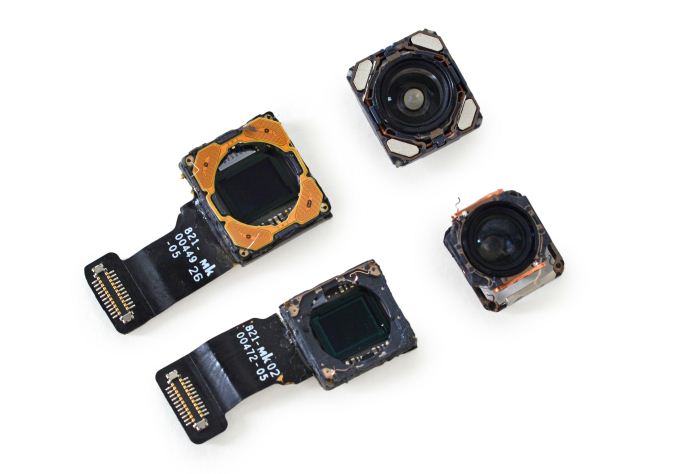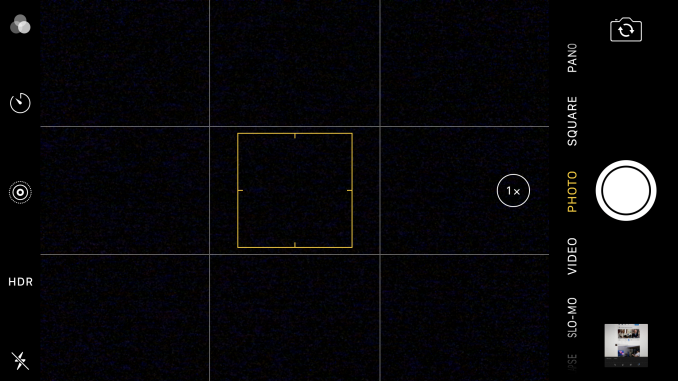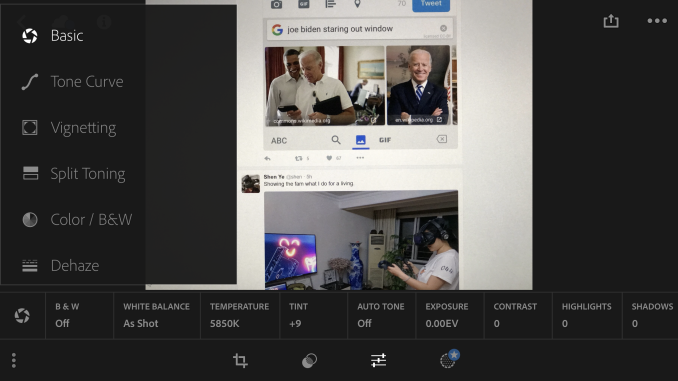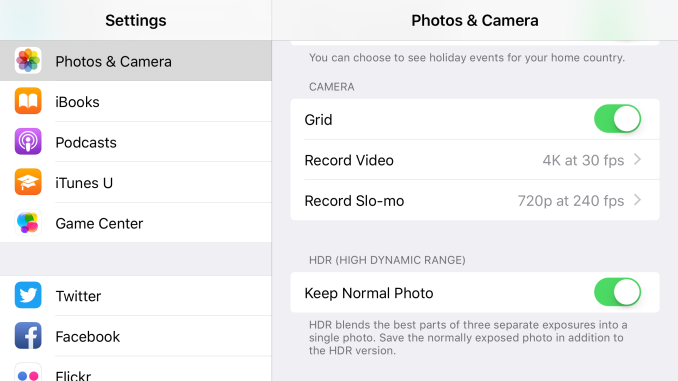The iPhone 7 and iPhone 7 Plus Review: Iterating on a Flagship
by Joshua Ho & Brandon Chester on October 10, 2016 8:00 AM EST- Posted in
- Smartphones
- Apple
- Mobile
- iOS
- iOS 10
- iPhone 7
- iPhone 7 Plus
Camera Architecture
Before we get into the results of the camera output it's always helpful to actually examine the basic characteristics and hardware that make up the camera as a number of characteristics can be predicted or understood by looking at the basic hardware. The CIS technology used can have significant impacts on noise, active area, and a number of other features including slow motion video capture. However, to say that the CIS is the only area worth examination ignores the whole chain of hardware and software needed to make a great camera. With that said we can start our look at the camera with the table below which summarizes a number of high level details for the camera.
| Apple iPhone Cameras | ||||
| Apple iPhone 6s Apple iPhone 6s Plus |
Apple iPhone 7 Apple iPhone 7 Plus |
|||
| Front Camera | 5.0MP | 7MP | ||
| Front Camera - Sensor | Sony ? (1.12 µm, 1/5") |
Sony Exmor RS (1.0 µm, 1/?") |
||
| Front Camera - Focal Length | 2.65mm (31mm eff) | 2.87mm (32mm eff) | ||
| Front Camera - Max Aperture | F/2.2 | F/2.2 | ||
| Rear Camera | 12MP | 12MP | ||
| Rear Camera - Sensor | Sony Exmor RS (1.22 µm, 1/3") |
Sony Exmor RS (1.22 µm, 1/3") |
||
| Rear Camera - Focal Length | 4.15mm (29mm eff) | 4mm (28mm eff) 8mm (56mm eff) Secondary |
||
| Rear Camera - Max Aperture | F/2.2 | F/1.8 F/2.8 Secondary |
||
Looking at the camera of the iPhone 7 in some ways the cadence has changed up a bit. While the iPhone 5s to iPhone 6 transition saw the use of almost identical camera sensor and optics, the iPhone 7 actually changes things up relative to the camera that we saw in the iPhone 6s, likely because the difference between the iPhone 6 and 6s camera was fairly mild in still photos. The iPhone 7 still appears to use a similar sensor on the rear, but with a new set of optics that incorporates a wider aperture. Apple seems to be fighting against serious z-height limitations, so we’re continuing to see a reduction in focal length as the iPhone 7 is now basically comparable to phones like the One M7 with its 28mm equivalent focal length. It’d be interesting to know transmission efficiency which would allow for proper comparisons between generations but considering how most dSLR lenses don't' list these specs it's not a surprise that we don't see this kind of disclosure.

iPhone 7 Plus's dual camera modules (Image Courtesy iFixit)
What isn’t listed on the spec sheet is that the iPhone 7 now has OIS, which is going to be a serious step up in terms of performance for anyone upgrading from the iPhone 6 or 6s. While Apple has some proprietary EIS that allows for really impressive performance despite the lack of OIS, a physical mechanism to compensate for hand shake is going to make for a more effective system in the first place, as it fixes the problem before the photons are captured. Apple continues to use advanced software to enable long exposure without visible blur or hand shake so the addition of OIS shouldn’t have any noticeable drawbacks other than increased shot latency in low light.
Of course, the iPhone 6s Plus already had OIS, so for the iPhone 7 Plus there is a new secondary camera with a focal length that is twice as long as the primary camera. However, the aperture is smaller, which means that in low light the system is going to automatically fall back to the primary camera which is still better in low light as far as I can tell, especially because the second camera lacks OIS. However, in bright daytime conditions the second camera’s longer focal length allows for better portraits and better detail in general. This helps to compensate for the iPhone’s sensor size and z-height limitations, but can only really help in daytime conditions.
Interestingly enough, Apple is actually one of the first OEMs to my knowledge to adopt a 1 micron pixel pitch for a camera sensor, but this is being done for the front-facing camera. I’m kind of curious to know what led to this decision as the optics are probably not going to be able to resolve such a small pixel size. We generally don’t review front-facing cameras but for the people that care about this sort of thing I suspect that the FFC is mostly a sidegrade in the sense that it’s probably going to be used to enable higher resolution video capture rather than higher quality still photos.
Camera UX
As far as the camera application goes, there’s really nothing new this generation. If you’ve taken pictures with a relatively new iPhone, you’re going to be right at home with the iPhone 7’s camera UI. For those that haven’t used a relatively new iPhone before we can do a quick review to discuss what is and isn’t present. At a high level, the UI is split up into a few logical sections, with mode-specific options in their own section. Modal selection is on the opposite side, with text that fairly clearly delineates the purpose of each mode. Below the modal selection, general options are presented for things like changing between front and rear cameras as well as the shutter button and camera roll.
It's hard to really say much about the iPhone camera UI at this point because it’s been polished to the point that there’s really no obvious criticisms to make about it. Apple may have made the mistake of shipping a 16:9 preview for a 4:3 camera before, but it’s been years since glaring issues like that have come up. Tapping to focus allows for either locking focus and exposure or biasing the exposure, which is going to provide coverage for 95% of still image cases. Of course, if you want more fine adjustment the default camera app is going to be inadequate, but there are plenty of good manual camera applications on the market like ProCam, ProShot, and Manual Camera.
It’s worth mentioning that while Apple was far from first to implement RAW capture on smartphones, their implementation is differentiated by a real end to end solution. Something like the HTC 10 really needs Lightroom to bring out the best in its RAW captures, although Snapseed is still reasonably useful in a pinch. Apple is leveraging their ecosystem which allows for things like fully featured Adobe Lightroom for RAW processing. I thought for a very long time that processing RAW was infeasible in the context of a smartphone TDP without fixed-function hardware, so it’s incredibly impressive to see Lightroom working smoothly when processing RAW images.
While most of the camera UX is designed well, one noticeable issue here is that the camera settings are integrated into the settings application rather than the camera application itself. If you’re used to how iOS works this makes sense, but things like resolution settings for video are placed in this menu rather than integrated into the camera application which makes switching between these settings relatively painful if you’re used to something like the HTC 10’s camera UI which places resolution settings in a slide-out drawer. This isn't a huge issue but it's definitely something I noticed due to the need to rapidly switch between resolution settings for video testing. Your mileage may vary here if you don't particularly care for such issues. Overall though, the camera UX has few friction points.













377 Comments
View All Comments
solipsism - Monday, October 10, 2016 - link
The 3" adapter has a very firm fit on your 3.5mm headphones; more so than your typical headphone jack on a smartphone. I'm sure this is intentional to help keep it in place.As mentioned in the article, wireless is the future, and while I've been using BT headphones for years now, my current ones (Bluez Aftershockz 2) finally broke so I'm using wired headphones until I the other headphones with Apple's W1 chip hit the market. I'm leaning toward the BeatsX as I prefer in-ear, and the connected cable, but I'm willing to give the AirPods a chance since so many are saying they are more comfortable than their included EarPods, which I find to be uncomfortable.
I've noticed that my wired headphone cable doesn't get tangled as easily and is easier to plug into my iPhone. I attribute this to both the slightly extra weight and thickness of the connector. I'd rather not be wired at all, but the adapter certainly hasn't been an issue. Since I only charge my phone once a day or every other day, this repeated claim that everyone needs to charge and listen to wired headphones as the same time escapes me. I'm guessing it's one of those invented problems only a few people actually need
greyhulk - Monday, October 10, 2016 - link
I hope you address thermal throttling in the deep dive. That's what I'm most interested in with the new A10.SydneyBlue120d - Monday, October 10, 2016 - link
While I really hope to see AV1 2160p60 with multichannel audio encoding with iPhone 8, I'd like to read a test comparison between Intel and Qualcomm modem, especially with Europe networks :) Thanks a lot.i4mt3hwin - Monday, October 10, 2016 - link
"Overall, the iPhone 7 and 7 Plus remain the best phones on the market for video capture. Strange issues with Snapdragon 820 video encode blocks mean that all Snapdragon 820 devices are just barely passable for video capture."I don't recall seeing this anywhere? I Know the OP3 article mentioned that the video was blocky - but I don't remember it linking that to the 820 - just a OP3 implementation issue? Does this mean the Pixel is going to experience similar issues?
grayson_carr - Monday, October 10, 2016 - link
I can confirm that my S7 Edge has this issue, and it's bad. When I first got it, I recorded a couple 4k videos while hiking along an oceanside trail and the blocky artifacts in the water and sky looked so crappy that I just never recorded videos with it again. It was technically 4k video, but it looked more like a 360p YouTube stream with the amount of blockiness, especially when panning up and down.lolipopman - Tuesday, October 11, 2016 - link
Why was this issue not explored by Samsung? I'm pretty sure it's not common or else it would've been known.lilmoe - Monday, October 10, 2016 - link
You do realize that the shutter speed on the iPhone's night images is twice as long as the others using lower ISO values, right?You call this "impressive"? I highly recommend a primer in photography.
JoshHo - Monday, October 10, 2016 - link
The exposure time of 1/4s is not indicative of all exposures. I would reference the iPhone 6s and 6s Plus reviews to better understand how Apple handles low light to avoid motion blur despite long exposures.lilmoe - Monday, October 10, 2016 - link
Yea, I've seen that review.Might I also suggest a primer in videography. Here's how a the video review portion should look like, and what it should include/test:
https://www.youtube.com/watch?v=4YCvLW2ySr0
Listen, I don't mean to insult you or anything, but you need to know that your criteria is fundamentally flawed. In addition to the objective truth that Samsung, and others, have the superior video (and audio), their image processing is what PEOPLE WANT. You give customers what they want, not what you think is best, especially for a mainstream product (ie: non-professional). If you want to compare sensor/lens quality, you compare RAW images using the same settings (but you didn't, for reasons).
Smartphone photography is about USABLE images/footage. You just don't apply the same criteria you do when reviewing a DSLR/DSLM.
Stop marketing "true colors" (which aren't exactly true, btw) for a crowd of users that apply filters to everything they post online.
Admit, correct and move on.
grayson_carr - Tuesday, October 11, 2016 - link
Samsung? Superior video? LMAO. Go home. You're drunk. I almost took you seriously until you said that out loud. -Galaxy S7 Edge owner